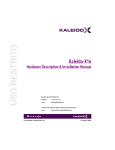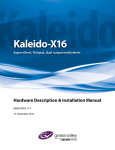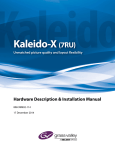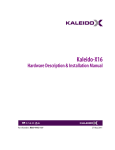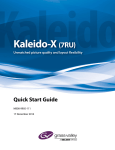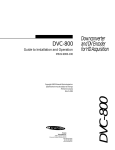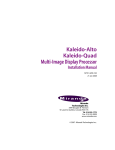Download Kaleido-X (KXA-FR7) Hardware Description and Installation Manual
Transcript
Kaleido-X (KXA-FR7) Hardware Description and Installation Manual M770-2700-102 23 Aug 2007 Miranda Technologies Inc. 3499 Douglas-B.-Floreani St-Laurent, Québec, Canada H4S 1Y6 Tel. 514-333-1772 Fax. 514-333-9828 www.miranda.com Kaleido-X (KXA-FR7) Hardware – Description and Installation Safety Compliance Information Safety Compliance This equipment complies with: - CSA C22.2 No. 60950-1-03 / Safety of Information Technology Equipment, Including Electrical Business Equipment. UL 60950-1 (1st Edition) / Safety of Information Technology Equipment, Including Electrical Business Equipment. st IEC 60950-1 (1 Edition) / Safety of Information Technology Equipment, Including Electrical Business Equipment. CAUTION These servicing instructions are for use by qualified service personnel only. To reduce the risk of electric shock, do not perform any servicing other than that contained in the operating instructions unless you are qualified to do so. Refer all servicing to qualified service personnel. Servicing should be done in a static-free environment. Electromagnetic Compatibility - This equipment has been tested for verification of compliance with FCC Part 15, Subpart B, class A requirements for Digital Devices. This equipment complies with the requirements of: EN 55022 Class A, Electromagnetic Emissions, EN 61000-3-2 & -3-3, Disturbance in Supply Systems EN 61000-4-2, -3, -4, -5, -6, -8 & -11 Electromagnetic Immunity CONTACT MIRANDA For technical assistance, please contact the Miranda Technical support centre nearest you: Americas Telephone: +1-800-224-7882 e-mail: [email protected] Asia Telephone: +81-3-5730-2987 e-mail: [email protected] Visit our web site at www.miranda.com Europe, Middle East, Africa, UK Telephone: +44 (0) 1491 820222 e-mail: [email protected] France (only) Telephone: +33 (0) 1 55 86 87 88 e-mail: [email protected] Kaleido-X (KXA-FR7) Hardware – Description and Installation Contents 1 Kaleido-X Multi-room, Multi-image Processor + Router ....................................................... 1 1.1 1.2 2 Overview.................................................................................................................................... 2 2.1 2.2 3 About This Document ............................................................................................................................2 Overview of the Kaleido-X System ........................................................................................................2 Mechanical Installation............................................................................................................. 4 3.1 3.2 4 Introduction ............................................................................................................................................1 Features.................................................................................................................................................1 Unpacking ..............................................................................................................................................4 Rack-mount installation .........................................................................................................................4 Frame and Electrical Installation............................................................................................. 4 4.1 Frame.....................................................................................................................................................4 4.2 Power supplies ......................................................................................................................................6 4.2.1 Installation .....................................................................................................................................6 4.2.2 Operation ......................................................................................................................................7 4.3 Ventilation ..............................................................................................................................................7 4.3.1 Frame Cooling Fans .....................................................................................................................7 4.3.2 Power Supply Cooling Fans:.........................................................................................................8 4.3.3 Card cooling fans ..........................................................................................................................8 4.3.4 Air Filter.........................................................................................................................................9 4.4 Card installation and replacement .........................................................................................................9 4.4.1 Rear Connector Panel installation ................................................................................................9 4.4.2 Card Removal ...............................................................................................................................9 4.4.3 Card installation ..........................................................................................................................10 5 Kaleido-X cards....................................................................................................................... 11 5.1 KXO-Dual-F card – description and connection ..................................................................................11 5.1.1 Rear Panel Connections .............................................................................................................12 5.1.2 Front card-edge layout................................................................................................................15 5.2 KXA-GPI card – description and connection .......................................................................................17 5.2.1 Rear Panel Connections .............................................................................................................18 5.2.2 Front Card-edge Layout..............................................................................................................20 5.3 KXI-16HSV-F card – description and connection ................................................................................22 5.3.1 Rear panel connections ..............................................................................................................23 5.3.2 Front card-edge layout................................................................................................................23 5.4 KXO-24Router card – description and connection ..............................................................................25 5.4.1 Rear panel connections ..............................................................................................................26 5.4.2 Front card-edge layout................................................................................................................27 6 Maintenance ............................................................................................................................ 29 6.1 6.2 6.3 7 Cleaning or replacing the air filter........................................................................................................29 Replacing a defective power supply ....................................................................................................29 Replacing a defective cooling fan........................................................................................................29 Kaleido-RCP2 .......................................................................................................................... 31 7.1 Introduction ..........................................................................................................................................31 7.2 Description...........................................................................................................................................31 7.3 Connections.........................................................................................................................................31 7.4 Control Surface Layout ........................................................................................................................32 7.5 Configuration .......................................................................................................................................34 7.5.1 Configuration Menu.....................................................................................................................34 7.5.2 Room Selection...........................................................................................................................35 Kaleido-X (KXA-FR7) Hardware – Description and Installation 7.5.3 DHCP Enable (network parameter) ............................................................................................36 7.5.4 IP address, subnet mask and gateway (network parameters)....................................................37 7.5.5 Restore Default Parameters .......................................................................................................38 7.5.6 Update the Kaleido-RCP2 Firmware...........................................................................................39 7.6 Operation .............................................................................................................................................44 7.6.1 Position Selection and Login.......................................................................................................44 7.6.2 Kaleido-RCP2 User Interface Activation .....................................................................................45 7.6.3 Kaleido-RCP2 Reset Solutions ...................................................................................................45 8 Audio Bridge Terminal............................................................................................................ 46 8.1 Introduction ..........................................................................................................................................46 8.2 Description...........................................................................................................................................46 8.3 Connections.........................................................................................................................................48 8.3.1 Audio inputs ................................................................................................................................48 8.3.2 Reference Input (looped through) ...............................................................................................49 8.3.3 Multiplexed audio outputs ...........................................................................................................49 8.3.4 Ethernet/Power ...........................................................................................................................49 8.4 Indicators .............................................................................................................................................49 8.5 Controls ...............................................................................................................................................50 8.6 Operation .............................................................................................................................................50 8.6.1 Synchronization...........................................................................................................................50 8.6.2 SDTI Link ....................................................................................................................................50 8.6.3 Audio Inputs ................................................................................................................................51 8.6.4 Web Interface..............................................................................................................................51 8.6.5 Live Update .................................................................................................................................58 9 Specifications ......................................................................................................................... 59 9.1 9.2 9.3 9.4 9.5 9.6 Kaleido-X Inputs ..................................................................................................................................59 Kaleido-X Outputs................................................................................................................................60 Kaleido-X Control.................................................................................................................................62 Kaleido-X Frame..................................................................................................................................63 Kaleido-RCP2 ......................................................................................................................................63 Audio Bridge Terminal (ABT) ...............................................................................................................63 Kaleido-X (KXA-FR7) Hardware – Description and Installation 1 Kaleido-X Multi-room, Multi-image Processor + Router 1.1 Introduction Kaleido-X is a multi-room, multi-image display Kaleido-X is a multi-room, multi-image display processor and router in a single, expandable chassis. Its unique mix of capabilities represents the most integrated monitoring and routing solution. As a multi-image processor, it offers the highest level of signal flexibility. Each chassis can display 96 HD, SD or Analog inputs any number of times, in any size, across 8 displays of any resolution and orientation. As a router, it offers switching of 96 unprocessed inputs to 48 HD/SD outputs for feeding monitors, test equipment and master control or production switchers. 1.2 Features EXPANDABLE Expandable multi-room architecture, based on a chassis with 96 inputs, and 8 independent multi-image display outputs. UNMATCHED FLEXIBILITY True any source, repeated to any position, to any display, at any size, at any resolution - without blocking or grouping restrictions. BUILT-IN ROUTER Built-in router with access to any unprocessed HD/SD-SDI input for feeding monitors, test equipment and master control or production switchers. SUPERIOR DISPLAY Highest quality multi-image output without compression, with superior onscreen graphics, for the most critical live monitoring applications. 2304 AUDIO CHANNELS Unprecedented audio performance with the ability to monitor up to 2304 channels of audio, including embedded, discrete AES, or discrete analog. MULTI-ROOM LAYOUTS Intuitive layout editor software allows rapid creation of multi-room layouts, which can be recalled quickly from networked remote control panels. HIGHLY ROBUST Highly robust design, with multiple points of redundancy, and no single point of failure for reliable 24/7 operation. Page 1 of 64 Kaleido-X (KXA-FR7) Hardware – Description and Installation 2 Overview 2.1 About This Document This document contains physical descriptions, installation instructions and connection information for the Kaleido-X frame and the cards that install in it. 2.2 Overview of the Kaleido-X System Figure 2.1 shows a basic Kaleido-X system configuration, with a single Kaleido-X feeding 8 monitor wall displays. The Kaleido RCP2 would be located on the production desk, while the Client PC could be anywhere with internet access to the network. Display A1 Display A2 Display B1 Display B2 1280 x 1024 @ 60 1280 x 1024 @ 60 1280 x 1024 @ 60 1280 x 1024 @ 60 Display C1 Display C2 Display D1 Display D2 1280 x 1024 @ 60 1280 x 1024 @ 60 1280 x 1024 @ 60 1280 x 1024 @ 60 DVI Outputs to displays Kaleido-RCP2 Client PC for XEdit and XAdmin PSU-PoE Video Input Connections PWR 10M100M 1 2 3 4 5 6 7 8 9 101112 ACTACT COLCOL SWITCH 131415161718192021222324 1 2 3 4 5 6 7 8 9 10 11 12 13 14 15 16 17 18 19 20 21 22 23 24 UPLINK Ethernet Switch Fig. 2.1 A basic Kaleido-X system configuration Page 2 of 64 Kaleido-X (KXA-FR7) Hardware – Description and Installation USB USB Client PC Ethernet SDTI Audio { HD/SD SDI or Composite (16) SDTI Audio { SDTI Audio { Video SDTI Audio Audio HD/SD SDI or Composite (16) HD/SD SDI or Composite (16) GPI A (24 bidirectional) GPI B (24 bidirectional) GPI C (24 bidirectional) REF KXI 16 C KXI 16 D KXI 16 E KXI 16 F KXAGPIGEN Head 1 { Audio Mouse Keyboard HD/SD SDI or Composite (16) Video USB Ethernet Audio Keyboard RCP2 Video USB Audio Mouse KXO Dual A KXI 16 B (DVI or RGBHV) Control HD/SD SDI or Composite (16) DVI-D HD/SD SDI DVI-D RGBHV Analog Audio AES Audio LTC IN (3) Ethernet USB (4) RS-422 (Analog or AES) Head 2 Video SDTI Audio SDTI Audio OUT KXI 16 A Midplane Audio { Audio ABT REF IN + loop through Ethernet SDTI Audio Video SDTI Audio OUT GPI { { REF Audio IN (varies with model) HD/SD SDI or Composite (16) Video Figure 2.2 gives a more detailed illustration of the Kaleido-X system and its inputs and outputs. Examples of the various external devices that connect to the Kaleido-X are also shown. DVI-D HD/SD SDI DVI-D RGBHV Analog Audio AES Audio (DVI or RGBHV) KXO Dual B } (as KXO-Dual A) KXO Dual C } (as KXO-Dual A) KXO Dual D } (as KXO-Dual A) KXO-24 Router A KXO-24 Router B Video Audio Video Display Audio Monitoring Display } HD/SD SDI (24) HD/SD SDI (24) HD/SD SDI (24) } HD/SD SDI (24) HD/SD SDI (24) HD/SD SDI (24) PS A AC power PS B AC power Kaleido-X Fig. 2.2 Kaleido-X system block diagram Page 3 of 64 Kaleido-X (KXA-FR7) Hardware – Description and Installation 3 Mechanical Installation 3.1 Unpacking Make sure the following items have been shipped with your Kaleido. If any of these are missing, contact your distributor or Miranda Technologies Inc. - Kaleido unit, with pre-installed cards and power supplies - 2 AC power cords - a CD-ROM of system software, release notes and a Quick Start manual. - keyboard - mouse 3.2 Rack-mount installation Kaleido may be installed in a standard 19” rack, using the proper screws and washers (not included). The Kaleido-RCP2 Remote Control Panel may also be installed in a rack using the optional KRCP-RK2 mounting kit. For proper ventilation, make sure the front and rear panel air vents are not blocked and the air filter is clean. 4 Frame and Electrical Installation Kaleido-X is a self-contained unit consisting of a frame, redundant power supplies, and various input and output cards. The monitor wall displays and external control devices complete the system. 4.1 Frame The frame is 7 RU high. It incorporates an internal midplane for interconnecting the cards. Cards are installed from the front of the frame. Each card is associated with input and/or output connectors which are mounted on a connector panel. These connector panels are installed from the rear of the frame, in the same horizontal position as their associated card. The redundant power supplies are installed at the top of the frame. The hinged front door can be opened to give access to the cards. A removable retaining bar across the front of the frame inside the door holds the cards securely in place. The Kaleido-X frame incorporates the following key sections: • A rack-mountable mechanical framework • A side-opening, removable and lockable door to cover and protect the front of the frame and the installed cards • A midplane board that enables inter-card communication • Slots for installing signal processing cards that plug into the midplane • Mounting points for rear connector panels • Redundant power supplies • Ventilation Page 4 of 64 Kaleido-X (KXA-FR7) Hardware – Description and Installation The front slots and rear panel connection points are color-coded according to the type of card that can be located in the slot. The extractor handles on the cards are color-coded to match. The cards are physically configured so they cannot be installed in the wrong type of slot. Note: The Output module slots D and C are considered as Master slots for Kaleido-X’s internal redundancy process, so it is recommended that the output modules be installed starting with D, C, then B and A. An output card MUST be present in either D or C, or the system will not boot. Slot # Function 1 2 3 Main Option Option A B 4 5 Input A Input B 6 7 Input Input C D 8 Input E 9 10 11 12 13 Input Output Output Output Output F A B C D / Exp Color From left to right as seen from the front of the frame, the available slots are as follows SLOTS COLOR CODE FUNCTION CARD TYPES Grey Main KXA-GPI-GEN 2-3 Purple Option KXO-24 HD/SD-SDI Router KXO-24 SD-SDI Router 4-9 Green Input KXI-16HSV-F KXI-16HS-F KXI-16SV-F 10-12 Yellow Output KXO-Dual-F 13 Yellow Output/Expansion KXO-Dual-F 1 Page 5 of 64 Kaleido-X (KXA-FR7) Hardware – Description and Installation 4.2 Power supplies 4.2.1 Installation The Kaleido is powered by dual redundant power supplies. These are installed at the top of the frame above the cards. The supplies are installed and removed from the front of the frame. These supplies are hotswappable, so that a defective supply may be replaced without removing the Kaleido from service. Access the power supplies by opening the front door of the frame. The two power supplies are located at the top, above the card slots. Viewed from the front of the frame, PSU A is located on the left-hand side, and PSU B is located on the right-hand side. PSU A PSU B Spring-loaded fasteners To remove a power supply: 1. Open the front door of the frame and locate the two power supplies at the top 2. Pull on the spring-loaded fastener at the left of the supply you wish to remove until it retracts from the hole in the frame. 3. While the fastener is retracted, grasp the handle on the front of the supply, and pull the supply out of the frame. The fastener can be released once the supply has moved about an inch (2.5 cm) Page 6 of 64 Kaleido-X (KXA-FR7) Hardware – Description and Installation To install a power supply: 1. Position the supply in front of an empty power supply slot in the top front of the frame, with the connector end towards the frame 2. Slide the power supply into the empty slot, moving it gently until it contacts the sockets at the rear of the slot 3. Push firmly but gently on the power supply handle until the power supply’s connectors have mated with the frame’s sockets, and the power supply will go in no further. 4. As the supply reaches its final position, the spring-loaded fastener at the left-hand side of the supply will engage the frame, securing the power supply in place. You may need to pull the fastener out before the supply can be pushed into its final position. 4.2.2 Operation Separate AC connectors are provided for the two power supplies, and are located at the top right of the rear of the frame. Connect both power supplies to an appropriate power source using the supplied power cords. • • The top power socket is for PSU A The bottom power socket is for PSU B Note that there is no ON/OFF switch for the Kaleido-X, so it will be in operation when the power is applied. A fully populated Kaleido-X frame will draw nearly 15 amps of current, so make sure that the circuit to which it is connected can handle that load, and that of any other connected devices. 4.3 Ventilation The Kaleido-X frame is cooled by ventilation fans. Fans are located in key positions within the frame. 4.3.1 Frame Cooling Fans Primary ventilation for the cards installed in the frame is handled by six fans located at the top rear of the frame, behind the power supplies. IMPORTANT The Kaleido-X requires a constant flow of cooling air during operation. DO NOT OPERATE THE UNIT IF THESE FANS ARE NOT WORKING. See section 6.3. Page 7 of 64 Kaleido-X (KXA-FR7) Hardware – Description and Installation These fans draw air into the frame through a grille and filter in the front door, and exhaust it through the grate on the rear of the fan assembly 4.3.2 Power Supply Cooling Fans: Each power supply has three fans located on the front of the supply immediately behind the extraction handle. 4.3.3 Card cooling fans Some of the cards in the Kaleido-X system are equipped with on-board fans to ensure proper cooling of key components. These fans focus the air flow provided by the frame cooling fans. Page 8 of 64 Kaleido-X (KXA-FR7) Hardware – Description and Installation Card Fans KXO-Dual-F 4 KXO-Router 2 KXI-16HSV-F 4 KXA-GPI-GEN 0 4.3.4 Air Filter Cooling air drawn into the Kaleido-X frame by the ventilating fans passes through a filter located behind a grill in the front door of the frame. Instructions for cleaning or replacing the filter are given in section 6.1 4.4 Card installation and replacement This section describes the installation of rear connector panels and cards in the Kaleido-X frame. 4.4.1 Rear Connector Panel installation 1. Remove the blank rear panel or the rear panel from the previously-installed card, using a screwdriver to loosen the two captive screws. 2. Position the new rear panel in the vacant location so its connectors are aligned with the corresponding plugs, and push it gently into place so the connectors mate. 3. Secure the panel in place, using a screwdriver to tighten with the two captive screws. 4.4.2 Card Removal 1. Open the front door of the frame and locate the card to be removed. IF THE CARD IS A KXO-Dual-F CARD, perform a clean shut-down by pushing the RESET button on the front card edge until the CPU LED starts blinking orange. Wait for 4 RED LEDs to turn on at the bottom left-hand side of the KXO card. These indicate the card is shut down and can be safely removed 2. Remove the card retaining bar by unscrewing the captive screw on the right side, and pulling it out of the slot at the left side. 3. Pull the ends of the two extractor handles out and away from the center of the card, levering it out of its connector. 4. Grasp the extractor handles, and pull the card gently straight out of the slot. Page 9 of 64 Kaleido-X (KXA-FR7) Hardware – Description and Installation 4.4.3 Card installation 1. Open the front door of the frame and locate an empty slot appropriate for the card type Note: the cards are mechanically configured so that it is not possible to install a card in the wrong slot 2. Remove the card retaining bar by unscrewing the captive screw on the right side, and pulling it out of the slot at the left side 3. Orient the card so that the labelled and color-coded extractor handle is at the top and the connectors are toward the frame 4. Slide the card all the way into the slot until it touches the connectors 5. Push gently on the extractor handles until the connectors mate and the card is completely into the slot. 6. Install the card retaining bar by slipping it into the slot on the left side of the frame and fastening the captive screw on the right side Page 10 of 64 Kaleido-X (KXA-FR7) Hardware – Description and Installation 5 Kaleido-X cards 5.1 KXO-Dual-F card – description and connection The KXO-Dual-F card is one of a series of output cards that can be installed in the Kaleido-X system. It is a Dual Head output card, meaning that it supports two completely independent outputs. These outputs, called Head 1 and Head 2, are each provided with a complete set of connectors. The KXO-Dual-F card is a multi-function card that performs a significant portion of the signal processing required to create the monitor wall output. It incorporates a mezzanine card mounted on the component side. It is complemented by a rear panel connector KXO-Dual-R that houses all input and output connectors associated with the card. KXO-Dual-F cards can be installed in any of the four available “Output” slots in the Kaleido-X frame. These slots are color-coded YELLOW on the front and rear panel of the frame. A Kaleido-X system must contain at least one KXO-Dual-F card, and may have up to four. In cases where there are two or more cards, one card serves as the “master” card, and the others are “slaves”, from a processing point of view. • The “Master card” MUST be located in slot C or D, and if both slots are occupied the card in D becomes the “master”. • If the card in slot D is removed, the card in C will assume the master role automatically. • The cards in A and B can never be “master”. Page 11 of 64 Kaleido-X (KXA-FR7) Hardware – Description and Installation Be careful to install the KXO-Dual-R rear panel in the matching location at the rear of the frame. • The KXO-Dual-F card and its rear panel can be installed in any order. Note 1: Kaleido-X cards are hot-swappable – it is not necessary to turn off the Kaleido-X when installing or exchanging cards. IMPORTANT NOTE FOR THE KXO-Dual-F CARD: Although the card is hot-swappable, it has a lot of on-board data, and should be shut down cleanly before being removed. Push the CPU ON/OFF button on the front card edge until the CPU LED starts blinking orange. Wait for 4 RED LEDs to turn on at the bottom left-hand side of the KXO card. These indicate the card is shutdown and can be safely removed Instructions for installing the card and the rear panel are given in sections 4.4.1 and 4.4.2. The KXO-Dual-F card is connected to the other cards in the Kaleido-X frame through the frame’s internal mid-plane. External connections to the KXO-Dual-F card are made through connectors that are found in two locations: • on the KXO-Dual-R rear panel • on the KXO-Dual-F front card edge 5.1.1 Rear Panel Connections Bottom of panel Top of panel The rear panel layout is divided into three sections, corresponding to these functionalities: • Head 1 – connectors located at the top of the rear connector panel (right-hand side when the card is oriented horizontally to read the connector labels) • Head 2 – connectors located at the bottom of the rear connector panel (left-hand side when the card is oriented horizontally to read the connector labels) Page 12 of 64 Kaleido-X (KXA-FR7) Hardware – Description and Installation • Control – connectors located in the middle of the rear connector panel (centre when the card is oriented horizontally to read the connector labels) 5.1.1.1 Rear panel connectors associated with the output heads Connector Labels Head 1 Head 2 HD/SD SDI OUT 1 HD/SD SDI OUT 2 Connector Function type BNC Serial digital HD or SD output signal for monitoring purposes (not yet supported) DVI-D IN 1 DVI-D IN 2 DVI DVI input signal that can be used as a background in the monitor wall display in place of the internally-generated background DVI-D OUT 1 DVI-D OUT 2 DVI DVI digital output (no analog signal on this connector) RGBHV OUT 1 RGBHV OUT 2 DE-15S High-resolution analog component output to feed the monitor wall display ANALOG OUT 1 L ANALOG OUT 2 L WECO Analog audio output (left channel) to feed the audio monitoring system ANALOG OUT 1 R ANALOG OUT 2 R WECO Analog audio output (right channel) to feed the audio monitoring system AES OUT 1 AES OUT 2 WECO Digital audio output (AES) to feed the audio monitoring system OPTION 1 OPTION 2 RJ-45 (for future use) Page 13 of 64 Kaleido-X (KXA-FR7) Hardware – Description and Installation 5.1.1.2 Rear panel connectors for card control Connector label Connector type Function LTC IN 1 BNC Time code input #1 LTC IN 2 WECO Time code input #2 LTC IN 3 WECO Time code input #3 ETHERNET RJ-45 100 Base-T ethernet connection USB USB A Connect a mouse, keyboard, or USB flash memory for software upgrade or data backup. Note that there are three other USB ports accessible on the front of the card that serve the same functions. RS-422 RJ-45 (see note below) Connect to an RS-422 (SMPTE 207M, EBU-3245) or RS-485 device or network Note: The RJ-45 connector is used to preserve space on a busy panel. The RS-422 interface specifies a DE9S connector, so if you are using this interface you will require a DE-9S-to-RJ-45 adapter cable. Miranda supplies such a cable, correctly wired for this application: Miranda part no. 1737-3000-102 The pinout for the RS-422 signals on the Kaleido-X RJ-45 connector, and the wiring diagram for an appropriate adapter cable, are shown here: is as follows: RJ45 1 2 3 4 5 6 7 8 RX+ RX– TX+ TX– Pinout of the RJ-45 connector on the KXO-Dual-R rear panel. to Kaleido-X 1 2 3 4 5 6 7 8 RJ45 RXTX+ RX+ TX- 1 2 3 4 5 6 7 8 9 to RS-422 DE-9 Wiring diagram for an RJ-45-to-DE-9 adapter cable to connect the Kaleido-X to an RS-422 network. Page 14 of 64 Kaleido-X (KXA-FR7) Hardware – Description and Installation 5.1.2 Front card-edge layout 5.1.2.1 Front card-edge connectors The front card-edge connectors are not accessible in normal use, as they are covered by the front door of the frame. They are provided for maintenance purposes, or for special circumstances. One exception is the recessed USB connector, which can be used to hold a USB flash memory stick that can be left in place during operation with the door closed Connector label Connector type Function USB USB A Connect a mouse, keyboard, or USB flash memory for software upgrade or data backup. USB USB A Connect a mouse, keyboard, or USB flash memory for software upgrade or data backup. USB USB A Connect a mouse, keyboard, or USB flash memory for software upgrade or data backup. (unlabeled) ICAT (for factory use only) Page 15 of 64 Kaleido-X (KXA-FR7) Hardware – Description and Installation 5.1.2.2 Front card-edge Indicators These LED status indicators are visible on the front edge of the card. LED label Card status CPU status DVI 1 DVI 2 LTC 1 LTC 2 LTC 3 LED color interpretation Green OK Orange Warning Red Configuration failed Flashing red Firmware upgrade in progress OFF Card is powered off Orange OS is booting up Blinking Green KXS application is starting Steady Green KXS application is up and running Blinking Red Software upgrade in progress OFF No input GREEN DVI input detected on Head 1 Orange Test OFF No input GREEN DVI input detected on Head 2 Orange Test Green Valid LTC signal at LTC 1 input Red No LTC signal or invalid signal at LTC 1 input Green Valid LTC signal at LTC 2 input Red No LTC signal or invalid signal at LTC 2 input Green Valid LTC signal at LTC 3 input Red No LTC signal or invalid signal at LTC 3 input 5.1.2.3 Front card-edge controls Two push buttons are located on the front card edge of the KXO-Dual-F card: Button label Function Bypass Toggle the display of video on the DVI-D outputs CPU ON/OFF Clean shut down before removing card All other adjustment, alignment and configuration of this card is accomplished using external controllers, e.g. X-Edit software, and is documented in their respective manuals Page 16 of 64 Kaleido-X (KXA-FR7) Hardware – Description and Installation 5.2 KXA-GPI card – description and connection The KXA-GPI-GEN card provides status monitoring, genlock and GPI interfacing for the Kaleido-X. The KXA-GPI-GEN card fits in the Kaleido-X Frame. It is complemented by a rear panel connector KXA-GPIGEN-R that houses all input and output connectors associated with the card. Instructions for installing the card and the rear panel are given below The KXA-GPI-GEN card must be installed in the MAIN slot in the Kaleido-X frame. This slot is color-coded GREY on the front and rear panel of the frame. • • Be careful to install the KXA-GPI-GEN-R rear panel in the matching location at the rear of the frame. The KXA-GPI-GEN card and its rear panel can be installed in any order. Note: Kaleido-X cards are hot-swappable – it is not necessary to turn off the Kaleido-X when installing or exchanging cards. Instructions for installing the card and the rear panel are given in sections 4.4.1 and 4.4.2. The KXA-GPI-GEN card is connected to the other cards in the Kaleido-X frame through the frame’s internal mid-plane. Page 17 of 64 Kaleido-X (KXA-FR7) Hardware – Description and Installation 5.2.1 Rear Panel Connections External connections to the KXA-GPI-GEN card are made through connectors mounted on the KXA-GPIGEN-R rear panel. These connectors carry both input and output signals. Bottom of panel Top of panel Rear panel connectors: Connector label Connector type Function GPI A 1-24 DB-50 (female) GPI A input/output (bi-directional) connections GPI B 1-24 DB-50 (female) GPI B input/output (bi-directional) connections GPI C 1-24 DB-50 (female) GPI C input/output (bi-directional) connections REF INPUT BNC Reference signal to genlock the Kaleido KX to the local plant. Supported Reference formats: • SMPTE 170M • SMPTE 318M • ITU 624-4 • BUT 470-6 • PAL and NTSC composite sync • SMPTE 274M • SMPTE 296M • SMPTE 240M GPI I/O connections: The three GPI connectors each support 24 bidirectional GPI contacts. Each individual GPI can be configured via software as an Input or Output GPI. They are identified in the software as: • • • GPI A – line 1 to 24 GPI B – line 1 to 24 GPI C – line 1 to 24 The pinouts of all three connectors are identical, and are shown in the following table. Page 18 of 64 Kaleido-X (KXA-FR7) Hardware – Description and Installation Pinout for GPI A, GPI B and GPI C connectors Pin Signal Pin Signal Pin Signal 1 22N 18 23N 35 24N 2 22P 19 23P 36 24P 3 19N 20 20N 37 21N 4 19P 21 20P 38 21P 5 16N 22 17N 39 18N 6 16P 23 17P 40 18P 7 13N 24 14N 41 15N 8 13P 25 14P 42 15P 9 10N 26 11N 43 12N 10 10P 27 11P 44 12P 11 7N 28 8N 45 9N 12 7P 29 8P 46 9P 13 4N 30 5N 47 6N 14 4P 31 5P 48 6P 15 1N 32 2N 49 3N 16 1P 33 2P 50 3P 17 GND 34 GND 51, 52 GND GPI Circuits The individual GPI contacts are reconfigurable as either inputs or outputs. For interfacing purposes, the input and output circuit configurations are as shown in these diagrams: VCC VCC 24.9 kOhms GPI #P Buffer GPI #P 200 Ohms FPGA in 1.5 kOhms GND GPI #N GPI configured as INPUT FPGA out GPI configured as OUTPUT To facilitate cabling of the GPI inputs and outputs, a terminal block adapter is available separately (Miranda item KXA-TBA-G) Page 19 of 64 Kaleido-X (KXA-FR7) Hardware – Description and Installation • The GPI Terminal Block adaptor accommodates up to 24 terminal block connections using positive and negative terminal connections. Each column on the terminal block has 6 positive and 6 negative terminal connections that correspond to each pin position. Column 1 Column 2 Column 3 Pins 1-6 Pins 7-12 Pins 19-24 1P 7P 19P 1N 7N 19N 2P 8P 20P 2N 8N 20N 3P 9P 21P 3N 9N 21N 4P 10P 22P 4N 10N 22N 5P 11P 23P 5N 11N 23N 6P 12P 24P 6N 12N 24N P=Positive, N= Negative, # = Position on 5.2.2 Front Card-edge Layout Page 20 of 64 Column 4 Pins 13-18 13P 13N 14P 14N 15P 15N 16P 16N 17P 17N 18P 18N Kaleido-X (KXA-FR7) Hardware – Description and Installation 5.2.2.1 Indicators These LED status indicators are visible on the front edge of the card. LED label LED color interpretation Card status Green OK Red Configuration failed Blinking Red System upgrade in progress Green OK Off No input Red Signal not recognized Orange Frame rate not supported Reference input status 5.2.2.2 Controls One push button is located on the front card edge of the KXA-GPI-GEN card: Button label Function Reset Reset the FPGA and restart the card – for maintenance use All other adjustment, alignment and configuration of this card is accomplished using external controllers, e.g. X-Edit software, and is documented in their respective manuals. 5.2.2.3 Front card-edge connector: An ICAT connector is located on the front card edge at the bottom below the RESET pushbutton. This connector is reserved for factory use, and has no user functionality. Page 21 of 64 Kaleido-X (KXA-FR7) Hardware – Description and Installation 5.3 KXI-16HSV-F card – description and connection The KXI-16HSV-F card is one of a series of input cards that can be installed in the Kaleido-X system. This card is a universal input card that accepts HD-SDI, SD-SDI and Composite inputs. Other cards in this series are: KXI-16HS-F KXI-16SV-F Composite inputs not supported HD-SDI not supported The KXI-16HSV-F card fits in the Kaleido-X Frame. It is complemented by a rear panel connector KXI-16-R that houses all input and output connectors associated with the card. The KXI-16HSV-F card can be installed in any of the six available “Input” slots in the front of the Kaleido-X frame. These slots are color-coded GREEN on the front and rear panel of the frame. • • Be careful to install the KXI-16-R rear panel in the matching location at the rear of the frame. The KXI-16HSV-F card and its rear panel can be installed in any order. Note: Kaleido-X cards are hot-swappable – it is not necessary to turn off the Kaleido-X when installing or exchanging cards. Instructions for installing the card and the rear panel are given in sections 4.4.1 and 4.4.2. The KXI-16HSV-F card is connected to the other cards in the Kaleido-X frame through the frame’s internal mid-plane. External connections to the KXI-16HSV-F card are made through connectors mounted on the KXI-16-R rear panel. Page 22 of 64 Kaleido-X (KXA-FR7) Hardware – Description and Installation 5.3.1 Rear panel connections The connectors located on the KXI-16-R rear panel are shown in the diagram and described in the table below. Bottom of panel Top of panel Connector label Connector type Function IN 1 to IN 16 BNC HD/SD SDI or composite video inputs 1 to 16 SDTI IN BNC Multiplexed audio from an external audio box (Audio Bridge Terminal) 5.3.2 Front card-edge layout Page 23 of 64 Kaleido-X (KXA-FR7) Hardware – Description and Installation 5.3.2.1 Front card-edge indicators These LED status indicators are visible on the front edge of the card (listed from top to bottom). LED label LED color interpretation Card Status Green Card OK Red Error Orange Programming in progress Blinking Red Upgrade in progress Green Valid signal present Red No signal or invalid signal Green Valid signal present Red No signal or invalid signal SDTI Status IN 1 Status -toIN 16 Status 5.3.2.2 Front card-edge controls One push button is located on the front card edge of the KXI-16HSV-F card: Button label Function Reset Reset the FPGA and restart the card – for maintenance use. 5.3.2.3 Front card-edge connector An ICAT connector is located on the front card edge at the bottom below the RESET pushbutton. This connector is reserved for factory use, and has no user functionality. Page 24 of 64 Kaleido-X (KXA-FR7) Hardware – Description and Installation 5.4 KXO-24Router card – description and connection The KXO-24Router card provides 24 external monitoring outputs that can be assigned to any of the 96 HD/SD SDI inputs of the Kaleido-X. Two cards can be installed in a Kaleido-X to provide up to 48 outputs. These unprocessed outputs can be used to feed high-quality CRT monitors, test equipment such as waveform monitors, as well as master control or production switchers. The router is available in two versions: • • KXO-24 HD/SD-SDI Router KXO-24 SD-SDI Router supports both HD-SDI signals and SD-SDI signals. supports SD-SDI signals only Signals of same format are switched in the vertical interval to avoid glitches. • The sync reference used for switching the output signals is derived from the signal connected to Input 1 of the KXI card installed in slot 4 in the Kaleido-X frame, i.e. the leftmost KXI card as seen from the front of the frame. Input Cards IN 1-16 KXI IN 17-32 KXI IN 33-48 KXI IN 49-64 KXI KXO-24Router Card Frame 16 V sync Genlock 16 16 24 96 Midplane 16 Reclockers & Cable Drivers Crosspoints 24 IN 65-80 KXI IN 81-96 KXI Out 1-24 (BNC) 16 24 16 Out (future use) In Kaleido-X Simplified Signal Flow Diagram – KXO-24Router Page 25 of 64 Kaleido-X (KXA-FR7) Hardware – Description and Installation The KXO-24Router card fits in the Kaleido-X Frame. It is complemented by a rear panel connector KXO-24 Router-R that houses all input and output connectors associated with the card. The KXO-24Router card can be installed in one of the two available “Option” slots in the front of the KaleidoX frame. These slots are color-coded PURPLE on the front and rear panel of the frame. • • Be careful to install the KXO-24 Router-R rear panel in the matching location at the rear of the frame. The KXO-24Router card and its rear panel can be installed in any order. Note: Kaleido-X cards are hot-swappable – it is not necessary to turn off the Kaleido-X when installing or exchanging cards. Instructions for installing the card and the rear panel are given in sections 4.4.1 and 4.4.2. The KXO-24Router card is connected to the other cards in the Kaleido-X frame through the frame’s internal mid-plane. External connections to the KXO-24Router card are made through connectors mounted on the KXO24Router-R rear panel. 5.4.1 Rear panel connections The connectors located on the KXO-24Router-R rear panel are shown in the diagram and described in the table below. Page 26 of 64 Kaleido-X (KXA-FR7) Hardware – Description and Installation Bottom of panel Top of panel Connector label Connector type Function OUT 1 to OUT 24 BNC Reclocked video outputs 1 to 24 IN Lanelink 12X 24 SDI signals from a router in another Kaleido-X frame OUT Lanelink 12X 24 SDI signals to a router in another Kaleido-X frame 5.4.2 Front card-edge layout Page 27 of 64 Kaleido-X (KXA-FR7) Hardware – Description and Installation 5.4.2.1 Front card-edge indicators A single LED status indicator is visible on the front edge of the card: LED label LED color interpretation Card Status Green OK Red Configuration failed Blinking Red System upgrade in progress 5.4.2.2 Front card-edge controls One push button is located on the front card edge of the KXO-24Router card: Button label Function Reset Reset the FPGA and restart the card – for maintenance use 5.4.2.3 Front card-edge connector An ICAT connector is located on the front card edge at the bottom below the RESET pushbutton. This connector is reserved for factory use, and has no user functionality. Page 28 of 64 Kaleido-X (KXA-FR7) Hardware – Description and Installation 6 Maintenance 6.1 Cleaning or replacing the air filter Occasionally, the air filter has to be cleaned in order to maintain proper ventilation. The air filter is located in the front door of the Kaleido-X frame. The filter may be cleaned without removing it from the door: 1. Remove the door from the frame by opening it, and lifting it straight up. 2. Place the door flat on a work surface with the inside of the door facing up. 3. Using a vacuum cleaner with a brush nozzle to prevent scratching, vacuum the dust from the inner side of the door. 4. Turn the door over and vacuum the outer side of the door. 5. Reinstall the door on the frame by positioning the hinge pins on the door over the hinge assembly on the frame, and lowering the door into place. 6.2 Replacing a defective power supply In the event of a power supply failure, the unit will switch to the redundant power supply for its power source. An alarm will appear on the Kaleido-X output screen, until it is manually reset through the Kaleido software. It is not necessary to turn off the unit before replacing the defective power supply. • Complete instructions for removing and re-installing a power supply are given in section 4.2.1 on page 6 of this manual. 6.3 Replacing a defective cooling fan The primary cooling fans for the Kaleido-X frame are located at the top rear of the frame. Six fans are mounted in a removable assembly. IMPORTANT The Kaleido-X requires a constant flow of cooling air during operation. DO NOT OPERATE THE UNIT IF THE FAN ASSEMBLY IS DISABLED OR REMOVED IN THE EVENT OF A FAN FAILURE: • please contact your nearest support center to get a replacement unit. • The system can run with failed fans, but the temperature should be closely monitored using XAdmin and the defective units replaced ASAP. To remove the fan assembly: 1. Power off the entire frame by unplugging the AC cords 2. Release the four captive mounting screws at the corners of the assembly’s panel 3. Pull the assembly straight out of the frame Page 29 of 64 Kaleido-X (KXA-FR7) Hardware – Description and Installation Once the defective fan has been replaced, reinstall the fan assembly: 1. Position the assembly in the opening 2. Slide the assembly into the opening so the four captive screws line up with their receptacles and the connectors mate with their plugs. 3. Tighten the four captive screws 4. Power up the frame by plugging in the AC cords 5. Verify that all six fans are running properly Page 30 of 64 Kaleido-X (KXA-FR7) Hardware – Description and Installation 7 Kaleido-RCP2 7.1 Introduction The Kaleido-RCP2 is a multi-function remote control panel designed for use with Miranda’s Kaleido-X. Ethernet connectivity allows multiple RCP2 users to access multiple Kaleido-X systems, allowing convenient access to the real-time operating features of the Kaleido-X 7.2 Description The Kaleido-RCP2 is a compact, freestanding controller. All operating controls are located on the top of the unit. It requires only a single ethernet cable for both connectivity and power. It also provides two USB ports allowing a USB mouse and keyboard to be connected. When logged into a Kaleido-X via its ethernet connection, it can control various operating features of the Kaleido-X 7.3 Connections The RCP2 is equipped with three connectors, located on the inside rear supports of the case. Ethernet / Power port The power for the Kaleido-RCP2 arrives on an RJ45 connector, and shares this connector with an ethernet interface. The RCP2 conforms to the IEEE 802.3af standard for powered devices Two kinds of power sources are supported: • midspan power source injector into an existing Ethernet network • power sourcing Ethernet switch. Full redundancy is obtained with both supplies present at the same time. Ethernet connectivity is 10/100 Mbps. Page 31 of 64 Kaleido-X (KXA-FR7) Hardware – Description and Installation 2 USB ports These ports are used to connect a mouse and keyboard, which may be used in operating the Kaleido-X Other USB devices, e.g. memory sticks, are not supported. 7.4 Control Surface Layout 1 5 4 3 2 The operating controls are laid out in functional groups: 1. Layout Presets The ten numbered keys laid out across the top of the panel are used to recall saved layouts to the Kaleido-X display, and are also used to save layouts. • Pressing and holding one of the preset buttons for 8 seconds will store the current layout to that button, allowing the user to easily return to it later • The layout associated with each button can be configured beforehand in XEdit A slot is provided above the keys to insert an easily-changed label to identify the saved layouts Page 32 of 64 Kaleido-X (KXA-FR7) Hardware – Description and Installation 2. Functions These function keys activate operating modes or functions on the Kaleido-X. INPUT ASPECT RATIO LOAD FULL SCREEN SAFE AREA SAVE ALARM INHIBIT UNDERSCAN UNLATCH STATUS The exact functionality of these buttons is determined by the configuration of the Kaleido-X. 3. Audio UP ARROW – increase the audio monitoring volume DOWN ARROW – decrease the audio monitoring volume MUTE – mute the audio monitoring (push on/push off) -20dB – attenuate the audio monitoring gain by 20dB (push on/push off) AUDIO MONITORING – audio source selection 4. Keypad The keypad buttons have double functions. Use the MOUSE LOCK button (top left) to switch between the two modes: • Numeric: All buttons at low brightness, alpha-numeric function as printed on each button is enabled • Mouse: Numeric function disabled, and some keys are assigned mouse-equivalent functions. The MOUSE LOCK button and the mouse-function keys are bright. Mouse Lock button KEY 2 = mouse move up. KEY 8 = mouse move down. KEY 4 = mouse move left. KEY 6 = mouse move right. KEY 7 = mouse left button. KEY 9 = mouse right button. 5. Display and operating keys DISPLAY – the LCD display shows messages and text entries LOGIN – log your Kaleido-RCP2 into a Kaleido-X through the ethernet interface ESC –menu navigation key ENTER – menu navigation key PANEL ENABLE – Enable/disable all other keys on this control panel, to prevent accidental operation NOTE: to reset the control panel – simultaneously press ESC, ENTER, DEL The use of these keys is described in Section 7.5 Configuration and Section 7.6 Operation Page 33 of 64 Kaleido-X (KXA-FR7) Hardware – Description and Installation 7.5 Configuration Before you can use your Kaleido-RCP2 to operate your Kaleido-X, you must set up the ethernet connection between the two devices. • The Kaleido-RCP2 is powered through the RJ-45 ethernet connector. There is no power ON/OFF button, so the device is ON when a powered ethernet cable is connected. Ethernet Configuration By default, the Kaleido-RCP2 is shipped with DHCP enabled, so it will automatically be assigned an IP address by a DHCP server. • If no DHCP server can be found, the Kaleido-RCP2 will default to its static IP address • The time-out period before the RCP2 defaults to its static address is about 1 minute o • To speed up the initialization, disable the DHCP option (see section 7.5.3) The default static IP address is 10.0.3.191, but this can be changed (see section 7.5.4) If you need to operate with a fixed IP address, you must use the Configuration menu to disable DHCP and set up the correct IP address, Network Mask and Gateway. • See sections 7.5.3 and 7.5.4 for detailed instructions. Room Selection Before you can operate a Kaleido-X, you must select a Room in which to operate. A list of available rooms can be accessed and one can be selected using the Configuration menu. • See section 7.5.2 for detailed instructions 7.5.1 Configuration Menu Resources for setting up the Kaleido-RCP2 to operate the Kaleido-X are available through the Configuration menu. The current menu item is shown on the LCD display on the Kaleido-RCP2 unit. Access the Menu by pressing the ENTER key for at least 8 seconds, then use these keys to navigate: 2 8 ENTER ESC move UP move DOWN access the submenu or select the displayed value move back to the previous menu level or abort a value selection These keys are lit when menu access is enabled. Page 34 of 64 Kaleido-X (KXA-FR7) Hardware – Description and Installation 7.5.2 Room Selection The table shows how to select the “ON AIR” room through the configuration menu. Selecting a specific room will give access to only the positions in this room for the login process. In the example, three rooms are available and are sent in a list that follows this order: RMA, RMB, RMC. We will select Room RMC. Action LCD indication Other Buttons Press and hold the ENTER key for 8 seconds to enter in the configuration menu. <at the end of the 8 seconds> Configuration ROOM SELECTION Digit keys 2 (UP) and 8 (DOWN), and the ENTER and ESC buttons, are lit; other digit keys are OFF (low). On ROOM SELECTION display, press ENTER again to get a room list from Kaleido systems that are available on the network at this moment. <for some time before a list is received> Acquiring room list... Digit keys 2 (UP) and 8 (DOWN), and the ENTER and ESC buttons, are lit; other digit keys are OFF (low). After the room list is displayed. ROOM Select RMA Digit keys 2 (UP) and 8 (DOWN), and the ENTER and ESC buttons, are lit; other digit keys are OFF (low). Pressing the 8 key twice brings you to the RMC room selection (using the 2 key moves you back on the previous selection) ROOM Select RMC Digit keys 2 (UP) and 8 (DOWN), and the ENTER and ESC buttons, are lit; other digit keys are OFF (low).. Page 35 of 64 Kaleido-X (KXA-FR7) Hardware – Description and Installation When the right room name is selected, you can: • press ENTER to validate the new selection • press on the ESC button to abort the selection and move back to the previous menu level . By pressing the ESC button after the selection process, you can leave the configuration menu. Configuration ROOM SELECTION Digit keys 2 (UP) and 8 (DOWN), and the ENTER and ESC buttons, are lit; other digit keys are OFF (low). RMC All buttons are dimmed 7.5.3 DHCP Enable (network parameter) The table shows how to enable or disable the automatic allocation of an IP address from a server. This option is commonly called DHCP (the protocol that is used for address allocation). For this example, the DHCP option is enabled and must be disabled. This task if performed through the configuration menu. Action LCD indication Other Buttons Press and hold the ENTER key for 8 seconds to enter in the configuration menu. <at the end of the 8 seconds> Configuration ROOM SELECTION Digit keys 2 (UP) and 8 (DOWN), and the ENTER and ESC buttons, are lit; other digit keys are OFF (low). On the ROOM SELECTION display, pressing the 8 key once leads you to the ETHERNET OPTIONS. Configuration ETHERNET OPTION Digit keys 2 (UP) and 8 (DOWN), and the ENTER and ESC buttons, are lit; other digit keys are OFF (low). By pressing ENTER, the Ethernet parameter menu is displayed. ETHERNET OPTIONS DHCP Digit keys 2 (UP) and 8 (DOWN), and the ENTER and ESC buttons, are lit; other digit keys are OFF (low). By pressing ENTER again, the current DHCP state is then displayed. DHCP ENABLE Digit keys 2 (UP) and 8 (DOWN), and the ENTER and ESC buttons, are lit; other digit keys are OFF (low). You can then select the DISABLE option by pressing the key 8 (pressing then the key 2 let you come back on the previous selection). DHCP DISABLE Digit keys 2 (UP) and 8 (DOWN), and the ENTER and ESC buttons, are lit; other digit keys are OFF (low). Confirm the selection by pressing the ENTER key. Abort the selection by pressing the ESC key. In both cases, you return to the previous menu level. ETHERNET OPTIONS DHCP Digit keys 2 (UP) and 8 (DOWN), and the ENTER and ESC buttons, are lit; other digit keys are OFF (low). Page 36 of 64 Kaleido-X (KXA-FR7) Hardware – Description and Installation Press the ESC key twice to leave the configuration menu. RMC All buttons are dimmed The Kaleido-RCP2 will reboot if the DHCP parameter was changed When you change the state of the DHCP option, the device must be restarted for this new option to take effect. This is done automatically but only when you leave the configuration menu. If you remain in the configuration menu, you can change any other parameters of the device in the configuration menu before this device will be restarted. 7.5.4 IP address, subnet mask and gateway (network parameters) The table shows how to set an IP address. In this example, the IP address is 10.0.3.191 and is changed to 192.168.0.10. This task is performed through the configuration menu. The method is the same for the Subnet Mask and the Gateway, so they have not been illustrated. Action LCD indication Other Buttons Press and hold the ENTER key for 8 seconds to enter in the configuration menu. <at the end of the 8 seconds> Configuration ROOM SELECTION Digit keys 2 (UP) and 8 (DOWN), and the ENTER and ESC buttons, are lit; other digit keys are OFF (low). Press the 8 key once to display the ETHERNET OPTIONS. Configuration ETHERNET OPTIONS Digit keys 2 (UP) and 8 (DOWN), and the ENTER and ESC buttons, are lit; other digit keys are OFF (low). Press ENTER to enter the ETHERNET OPTIONS submenu. ETHERNET OPTIONS DHCP Digit keys 2 (UP) and 8 (DOWN), and the ENTER and ESC buttons, are lit; other digit keys are OFF (low). Press the 8 key to display the next available option in the submenu (press the 2 key to return to the previous option). ETHERNET OPTIONS IP ADDRESS Digit keys 2 (UP) and 8 (DOWN), and the ENTER and ESC buttons, are lit; other digit keys are OFF (low). Press the ENTER key again to select this option and display the current IP address. IP ADDRESS 010.000.003.191 <the cursor blinks between a black square and the digit> All digit keys are lit as well as the ENTER, ESC, DEL and space (_) buttons You can move the cursor to the next digit position by pressing the “_” key… IP ADDRESS 010.000.003.191 <the cursor blinks between a black square and the digit> All digit keys are lit as well as the ENTER, ESC, DEL and space (_) buttons or use the DEL key to move the cursor back to the previous position. IP ADDRESS 010.000.003.191 <the cursor blinks between a black square and the digit> All digit keys are lit as well as the ENTER, ESC, DEL and space (_) buttons You can use the digit keys to change the current value. Also, pressing a digit key moves the cursor to the next position. IP ADDRESS 192.168.000.010 <the cursor blinks between a black square and the digit> All digit keys are lit as well as the ENTER, ESC, DEL and space (_) buttons Page 37 of 64 Kaleido-X (KXA-FR7) Hardware – Description and Installation When done, press ENTER to confirm the address or ESC to cancel the change and move back to the previous menu level ETHERNET OPTIONS IP ADDRESS All buttons are dimmed Press the ESC key twice to leave the configuration menu. RMC <if this room has been selected> All buttons are dimmed The Kaleido-RCP2 will reboot if any of the network parameters (IP address, subnet mask or gateway) was changed. When you change the state of one of the network parameters, the device must be restarted for this value to be applied. This is done automatically but only when you leave the configuration menu. If you remain in the configuration menu, you can change any other parameters of the device in the configuration menu before this device will be restarted 7.5.5 Restore Default Parameters The configuration menu of the Kaleido-RCP2 provides an option to restore the default parameters of the device. This option is called “FACTORY DEFAULT”. • Selecting this option will set back to their default values: o the network parameters o the room selection o the login position. • After this selection, leaving the menu will restart the device. Here are the default parameter values: DHCP: Enable Default IP address 10.0.3.191 Default Subnet Mask 255.255.0.0 Default Gateway 0.0.0.0 Current Room and Login position are erased from the Kaleido-RCP2 memory Action LCD indication Other Buttons Press and hold the ENTER key for 8 seconds to enter in the configuration menu. <at the end of the 8 seconds> Configuration ROOM SELECTION Digit keys 2 (UP) and 8 (DOWN), and the ENTER and ESC buttons, are lit; other digit keys are OFF (low). Press the 8 key three times to display FACTORY DEFAULT. Configuration FACTORY DEFAULT Digit keys 2 (UP) and 8 (DOWN), and the ENTER and ESC buttons, are lit; other digit keys are OFF (low). Press ENTER to enter the FACTORY DEFAULT submenu. FACTORY DEFAULT RESTORE Digit keys 2 (UP) and 8 (DOWN), and the ENTER and ESC buttons, are lit; other digit keys are OFF (low). Press ENTER to select the RESTORE function, or press ESC to move back to the previous menu item without restoring the factory values. FACTORY DEFAULT RESTORE Digit keys 2 (UP) and 8 (DOWN), and the ENTER and ESC buttons, are lit; other digit keys are OFF (low). Page 38 of 64 Kaleido-X (KXA-FR7) Hardware – Description and Installation Press the ENTER key again to restore the factory defaults. Configuration FACTORY DEFAULT Digit keys 2 (UP) and 8 (DOWN), and the ENTER and ESC buttons, are lit; other digit keys are OFF (low). Press the ESC key once and the Kaleido-RCP2 will reboot. (screen is blank after reboot) Low 7.5.6 Update the Kaleido-RCP2 Firmware The firmware of the Kaleido-RCP2 can be upgraded by downloading data through the Kaleido-RCP2’s ethernet connection. 1. You will need a PC connected to the same network as your Kaleido-RCP2 2. You will need a copy of the Kaleido-RCP2 Updater file on the PC • If an update is necessary, information about obtaining an updater installer will be provided by Miranda Tech Support • Run the Kaleido-RCP2 Updater Installer, and follow the on-screen instructions. • The sequence of installer screens is shown here: Page 39 of 64 Kaleido-X (KXA-FR7) Hardware – Description and Installation Once the Updater has been installed, double-click on its desktop icon to run it. • • The installer window will open on the desktop of the PC. The window includes step-by-step instructions at the top, and an action area beneath The initial window is shown here: Use this window to locate the firmware data file that will be used in the upgrade process Page 40 of 64 Kaleido-X (KXA-FR7) Hardware – Description and Installation A version of the file was installed when the updater installer was run, and will typically be found at the location: C\Program Files\Miranda\Kaleido-RCP2 updater\Firmware\735_xxx.CBN where xxx is the version number of the firmware that will be installed by the updater Firmware selection (step 1 of 3) 1. Make sure that the Kaleido-RCP2 that you want to update is on the same network as this PC. • Note that the upgrade may take as long as 15 minutes to complete 2. Select the version of the firmware that you want to upgrade to. • type the path into the data box if known • click Browse and navigate to the firmware folder if that is more convenient o if you click Browse, the Open window will permit you to navigate to the file o When you are done, the Choose the firmware data box will look something like this: 3. Click the "Next" button when you are done. The next window gives step-by-step instructions for downloading the data file to the Kaleido-RCP2: Page 41 of 64 Kaleido-X (KXA-FR7) Hardware – Description and Installation Update (step 2 of 3) 1. 2. 3. 4. 5. 6. 7. 8. On the RCP2, press and hold "ENTER" for 10 seconds until you see the configuration menu. Select the first option "ROOM SELECTION" by pressing "ENTER". Wait until the room data is downloaded to the RCP2. Select the room "System\Updater" and press "ENTER". Press the "LOGIN" button twice. Wait until the position data is downloaded to the RCP2. Select the position "Update Now!" and press "ENTER". The RCP2 asks you to enter the password. Enter the password "6472632" (Miranda) and press "ENTER". 9. The RCP2 downloads the new firmware. Progress information is shown in the Status section of the window • If a network problem occurs and the RCP2 stops downloading the firmware, go back to step 7. 10. The RCP2 validates the data, copies it into the main memory and then reboots. • You can follow the progress of this step on the RCP2 screen. • It takes several minutes to transfer the new firmware data to the main memory WARNING Page 42 of 64 • Do not disconnect the Kaleido-RCP2 while it is updating its firmware, as a fatal error may result. • In this event, it will be necessary to return the unit to Miranda to be reprogrammed. Kaleido-X (KXA-FR7) Hardware – Description and Installation Once the Kaleido-RCP2 has rebooted following the successful firmware upgrade, click Next on the PC Update window to open the final window, which gives instructions for verifying that the new firmware is installed and functional Verification (step 3 of 3) You can verify that your RCP2 is updated properly by following the steps below: 1. On the RCP2, press and hold "ENTER" for 10 seconds until you see the configuration menu. 2. Select the option "DEVICE INFO" and then press "ENTER". 3. Select the first option "VERSION" by pressing "ENTER". 4. The RCP2 displays the currently-installed version of the firmware. 5. If this number matches the version number in the updater file that you selected in the Choose the Firmware window in the first step, the update has been successful. Page 43 of 64 Kaleido-X (KXA-FR7) Hardware – Description and Installation 7.6 Operation Many of the operational functions of the Kaleido-RCP2 are determined by the configuration of the Kaleido-X operating environment, and are explained in the Kaleido-X documentation. 7.6.1 Position Selection and Login To use your Kaleido-RCP2, you must validate your access with the Kaleido system. Push LOGIN key and choose a position that corresponds to the type of user you are. You may require a password to log on. A room is supposed to be already set through the configuration menu of the device. Here is a graphical resume on the login menu as it appears on the LCD: text Login To display the LOGIN menu on the LCD, press the LOGIN key. Then, you can access any submenu or select values in the menu by pressing the ENTER key. The ESC key is used to abort a selection and leave the menu. Navigation through menu items is done using the key 2 and 8 as UP and DOWN arrows. LOGIN Position Enter password: Depends on the room that you have selected previously from the configuration menu. The positions are displayed in a list. This list can be scrolled up and down using the keys 2 and 8 as arrows. The password can contain up to 8 digits. Use the digit keys to enter the password. The “DEL” key let you erase the current password in a case of typing error. To validate the password, just press ENTER at the end of it. The table shows how to change the login position. In this specific example, the position “TD01” is changed for “TC01”. This task can only be accomplished after a room has been selected (see “ROOM Selection” in section 7.5.2). State of action LCD indication Other Buttons Acquiring login list... Lit the way they should (depends on the Kaleido system) Behavior after receiving the login position list LOGIN Position <first item of the list here> Digit buttons 2 and 8 are lit to indicate that they can be used to scroll the list Behavior if there is no list available. Kaleido system is active but it doesn’t send the list. No login list available <display for 3 seconds> Lit the way they should (depends on the Kaleido system) Behavior when the Kaleido system is not active. Target system is offline <display for 3 seconds> Low (depends on the Kaleido system) With a valid list that is displayed, press ESCAPE to abort the position selection. RMC TD01 Lit the way they should (depends on the Kaleido system) With a valid list that is displayed, press ENTER to select the new position. Enter password: Digit buttons are lit as well as the ENTER and ESC buttons Press Position Login, behavior before receiving the position list from the Kaleido system Page 44 of 64 Kaleido-X (KXA-FR7) Hardware – Description and Installation Press ESC to abort the position selection. RMC TD01 Lit the way they should (depends on the Kaleido system) Enter the password or not using the digit buttons (up to 8 digits) and press ENTER to confirm it. Enter password: **** <one star character per password digit> Digit buttons are lit as well as the ENTER and ESC buttons If the password is OK. Access granted <display for 2 seconds, then> RMC TC01 Low (depends on the Kaleido system) If the password is wrong Access is denied <display for 2 seconds, then> RMC TD01 Lit the way they should (depends on the Kaleido system) 7.6.2 Kaleido-RCP2 User Interface Activation The PANEL ENABLE button cycles the Kaleido-RCP2 between ENABLE and DISABLE modes. In the DISABLE mode: • • • • PANEL ENABLE LED is flashing. all other keys on the Kaleido-RCP2 are disabled (LEDs off). LCD display is completely off Peripherals connected to the Kaleido-RCP2’s USB ports are also disabled The purpose of the panel enable function is to lock the user interface of the remote. By doing so, you avoid any accidental access to the Kaleido system by the remote. 7.6.3 Kaleido-RCP2 Reset Solutions There are several means by which the Kaleido-RCP2 can be reset in the event of problems. Press “ENTER” + “ESC” + “DEL”. simultaneously High level software reset that restarts the device and does nothing else. Software and hardware watch-dogs. Automatic reset the device on software or hardware failure of the internal controller Disconnect and reconnect the Kaleido-RCP2’s Ethernet cable. Power up the remote and do nothing else. Page 45 of 64 Kaleido-X (KXA-FR7) Hardware – Description and Installation 8 Audio Bridge Terminal 8.1 Introduction The Audio Bridge Terminal (ABT) is an external audio multiplexer/serializer for the Kaleido-X. Kaleido-X supports embedded audio in SDI signals, but there are cases when embedded audio is not available (e.g. analog inputs, or not embedded) or extra audio inputs are required The Kaleido-X supports up to 96 inputs, and all of the video input connectors are located on the rear panels associated with the KXIseries of cards. There is not enough space on the rear panels to also include the audio connectors. The ABT provides connector space for the audio signal inputs, and multiplexes all the audio signals into combined serial feeds on coaxial cables that connect to the KXI cards. Features include: • 128 Channels of Audio processing • Analog or digital Audio Inputs • Dual redundant SDTI outputs on standard video coaxial cable • Internal tone generator • 0 dBFS adjustments on analog inputs • Locks to video, AES or Word clock reference (48 kHz only) • Compatible with non-PCM signals • Complies with IEEE 802.3af standard for Powered Over Ethernet devices • Occupies 3 rack units, 4 cm width (plus connectors) • Can fit in the back of racks • Can be located up to 800 feet (250m) away from the Kaleido-X 8.2 Description The ABT is designed to mount in a standard 19” rack, and is 3 RU high. All connections are from the rear. Page 46 of 64 Kaleido-X (KXA-FR7) Hardware – Description and Installation Figure 8.1 Audio Bridge Terminal – rear view There are 6 different models of the ABT, based on signal/connector type and capacity: Model designation Characteristics ABT-128D-110 128 digital ( 64 AES) inputs on WECO connectors (balanced, 110 Ω impedance) ABT-64D-110 64 digital (32 AES) inputs on WECO connectors (balanced, 110 Ω impedance) ABT-128D-75 128 digital (64 AES) inputs on BNC connectors (unbalanced, 75 Ω impedance) ABT-64D-75 64 digital (32 AES) inputs on BNC connectors (unbalanced, 75 Ω impedance) ABT-128A 128 analog inputs on WECO connectors (balanced, 110 Ω impedance) ABT-64A 64 analog inputs on WECO connectors (balanced, 110 Ω impedance) Figure 8.2 (a) ABT-128D-75 rear panel layout Figure 8.2 (b) ABT-128D-110 rear panel layout Page 47 of 64 Kaleido-X (KXA-FR7) Hardware – Description and Installation Figure 8.2 (c) ABT-64D-75 rear panel layout Figure 8.2 (d) ABT-64D-110 rear panel layout Figure 8.2 (e) ABT-128A rear panel layout Figure 8.2 (f) ABT-64A rear panel layout 8.3 Connections 8.3.1 Audio inputs The number and configuration of the audio inputs depends on the specific model of ABT you are using. Page 48 of 64 Kaleido-X (KXA-FR7) Hardware – Description and Installation 8.3.2 Reference Input (looped through) An external reference signal is required to synchronize the SDTI outputs. An analog video reference signal, word clock or AES-75 signal can be connected to one of the REFERENCE SIGNAL connectors. If the loopthrough is not used, a 75 ohm termination on the other REFERENCE SIGNAL connector must be used to properly terminate the line. For an Audio Bridge Terminal with an AES breakout panel, AES INPUT 1 can also be used for synchronization. This input signal must be error-free PCM audio sampled at 48 kHz. In the case where both REFERENCE SIGNAL and AES INPUT 1 have valid references, the signal connected to REFERENCE SIGNAL has priority. 8.3.3 Multiplexed audio outputs The multiplexed audio outputs are formatted to be compatible with the STDI audio input connections on the KXI-16 series of cards. The Serial Digital Transport Interface (SDTI) uses the Serial Digital Interface (SDI) developed to transport digital video signals as a carrier for other data types. It requires that the transmitter and receiver have the same codec. 8.3.4 Ethernet/Power The power for the ABT arrives on an RJ45 connector, and shares this connector with an ethernet interface. The ABT conforms to the IEEE 802.3af standard for powered devices Two kinds of power sources are supported: • midspan power source injector into an existing Ethernet network • power sourcing Ethernet switch. Full redundancy is obtained with both supplies present at the same time. 8.4 Indicators The ACTIVITY indicator is located on the right-hand side of the rear panel. This LED reports the status of the ethernet connection as follows: : Color Board Status Off No link detected Green Normal (good link) Orange Activity Red Hardware fault Flashing Red Upgrading firmware Page 49 of 64 Kaleido-X (KXA-FR7) Hardware – Description and Installation Front panel LEDS – Two LEDs are visible on the front panel, one for each power supply. When lit, they both indicate the same status: Color Board Status Green Normal Flashing Green Normal, rebooting Orange Warning Flashing Orange Warning, rebooting Red Hardware fault Flashing Red Upgrading firmware When the ABT is powered up, all three LEDs will be orange until the boot sequence is terminated. This is a visual indicator that the LEDs are functioning properly. 8.5 Controls The RESET pushbutton is located on the right-hand side of the ABT rear panel. Push the RESET pushbutton to reset the ABT’s IP address to a default value: • • IP address: Subnet mask: 10.0.3.190 255.255.0.0 This simplifies the process of connecting to the ABT via its ethernet connection. • The process is described in more detail in Section 8.6.4 Web Interface. 8.6 Operation 8.6.1 Synchronization An external reference signal is required to synchronize the SDTI outputs. An analog video reference signal, word clock or AES-75 signal can be connected to one of the REFERENCE SIGNAL connectors. If the loopthrough is not used, a 75 ohm termination on the other REFERENCE SIGNAL connector must be used to properly terminate the line. For an Audio Bridge Terminal with an AES breakout panel, AES INPUT 1 can also be used for synchronization. This input signal must be error-free PCM audio sampled at 48 kHz. In the case where both REFERENCE SIGNAL and AES INPUT 1 have valid references, the signal connected to REFERENCE SIGNAL has priority. 8.6.2 SDTI Link The two SDTI outputs are identical, each including signals from all inputs. Each SDTI output can be connected to a Kaleido-X input module or to a specific SDTI de-multiplexer. Page 50 of 64 Kaleido-X (KXA-FR7) Hardware – Description and Installation Depending on the number of input connections available, this link transports up to 128 channels of audio. The SDTI streams transport the current IP address of the Audio Bridge Terminal to the receiver. The connection via TCP/IP will give access to the different parameters and status. 8.6.3 Audio Inputs 8.6.3.1 Analog Audio Inputs The analog channels pass through analog to digital converters with 24 bit resolution and a 48 kHz sample rate. To compensate the level of the analog signal, the 0 dBFS value may be set from +24 dBu to -7 dBu for each channel through the web page interface. 8.6.3.2 Digital Audio Inputs The ABT operates on at 48 kHz-sampled audio signals, and inputs at different sampling rates may not be processed satisfactorily. The validity, user and channel status bits are transmitted alongside the PCM samples. The input error status detected by the digital input receiver can be monitored by the web page interface. The non-PCM data will pass unchanged. 8.6.4 Web Interface To access the web interface, the Audio Bridge Terminal must be connected to a local area network (LAN). If the unit's IP address is known, you can access the built-in web server by entering the address in a web browser connected to the same network. If the IP address is not known, it is possible to reset the unit's network configuration. You must set up a simple LAN comprised of: • one PC running the web browser • the Audio Bridge Terminal to be configured • a hub or switch for interconnection. Then follow these steps: 1. Connect the PC to the hub or switch. 2. Set the PC network configuration with the following parameters: • DHCP = OFF • Static IP address = 10.0.0.1 • Subnet mask = 255.255.0.0 • Default gateway = 10.0.0.1 3. Apply power to the Audio Bridge Terminal and make sure it is connected to the hub or switch. • • 4. If the hub or switch is Power over Ethernet (PoE) enabled, simply connect it to the unit using an Ethernet cable. If not, PoE mid-span ("inserter") equipment must be placed between the hub or switch and the Audio Bridge Terminal. Press the RESET pushbutton for at least 1 second. It is beside the ETHERNET/POWER RJ-45 connector. The Audio Bridge Terminal will reboot with the following static network configuration: • DHCP = OFF • Static IP address = 10.0.3.190 Page 51 of 64 Kaleido-X (KXA-FR7) Hardware – Description and Installation • • 5. Subnet mask = 255.255.0.0 Default gateway = 10.0.0.1 Using the browser, connect to the unit using the following address: 10.0.3.190. The webserver serves the web pages that allow monitoring and configuration of the parameters. • Access the pages by clicking on the links on the left-hand side of the current page. The individual pages are described in the following sections. 8.6.4.1 Status web page The "Status" web page reports the status of several aspects of the ABT unit. General Status – the overall status of the unit, as also reported by the front panel LED Text Text color LED color OK Green Green Warning Orange Orange Hardware Error Red Red Upgrading Bold Red Flashing Red PoE Mid-span – reports whether PoE mid-span equipment is Present (green text) or absent (normal text) PoE End-span – reports whether PoE end-span equipment is Present (green text) or absent (normal text) Reference – reports the status of the reference used for input signal synchronization: Text Text color Interpretation Freerun Orange No reference present {format name} Normal Identifies the reference that is present: Video NTSC PAL HD 1080/60i HD 1080/60i HD 1080/59.94i HD 1080/50i HD1080/24PsF HD1080/23.98PsF Audio HD 1080/30p HD 1080/29.97p HD 1080/25p HD 1080/24p HD 1080/23.98p HD 720/60p HD 720/59.94p HD 720/50p AES75 Word clock AES input 1 Note: all HD reference signals are analog with tri-level sync Inputs – reports the status of each of the audio inputs to the ABT. The page content for Input Status varies depending on the model of ABT being monitored. • • Number of inputs varies with model Analog and Digital inputs are reported differently: Page 52 of 64 Kaleido-X (KXA-FR7) Hardware – Description and Installation • • Analog inputs o Shows channel number only o Color of text varies with input status Analog Input status Text color OK * Normal Overload Red * Note: Silence will be reported as OK in this context. Digital inputs: o Reports status and input frequency for each channel o Channel number text color varies o Digital Input channel Text color OK Normal Overload Red Status report text color varies Digital Input status Text color OK Green Validity, CRCC errors Yellow Parity, Biphase errors Orange No lock Red Here are sample pages showing the treatment of analog (ABT-128A) and digital (ABT-128D) inputs: Figure 8.3 ABT-128A "Status" Web page Page 53 of 64 Kaleido-X (KXA-FR7) Hardware – Description and Installation Figure 8.4 ABT-128D "Status" Web page 8.6.4.2 Parameters web page The "Parameters" web page allows the configuration of different parameters. The "Tone" parameter activates or deactivates the EBU test tone applied simultaneously to all channels. The odd channel will be a 1 kHz sine wave at -18 dBFS with a period of silence lasting 250 ms every 3 seconds. The even channel will be a continuous 1 kHz sine wave at -18 dBFS. The "0 dBFS level" parameters are available for an Audio Bridge Terminal with analog inputs (see Figure 8.3). They allow the adjustment of the 0 dBFS level for each input. The number of inputs depends on the model. In the case where all inputs must be set to the same level, click the "Yes" radio button beside "Set all levels using CH 1". The changes take effect when the "Apply" button is clicked. If changes to parameters are made before clicking "Apply" and the user wishes to reestablish the values displayed when the page was loaded, this can be done by clicking the "Cancel Changes" button. Finally, factory default values for all parameters on this page can be displayed by clicking "Factory Defaults". Page 54 of 64 Kaleido-X (KXA-FR7) Hardware – Description and Installation Figure 8.5 ABT-128A "Parameters" Web page The Audio level adjustments are not applicable to ABT models with digital inputs and do not appear on the web page (see Figure 8.6). Figure 8.6 ABT-128D "Parameters" Web page Page 55 of 64 Kaleido-X (KXA-FR7) Hardware – Description and Installation 8.6.4.3 Network Configuration web page The "Network Configuration" page allows the configuration of the network parameters. Figure 8.7 ABT-128A "Network Configuration" Web page The "MAC Address" is the unique hardware address attributed to each Audio Bridge Terminal unit. Each unit has a different address, this being the only way to distinguish the units from each other when connected to a network. The "Label" parameter gives the unit a label. The label is found in the title of the web page. It can contain up to 16 characters. Valid characters are from the English alphabet (lowercase a through z, uppercase A through Z), numbers 0 through 9, the hyphen (-), the underscore (_) and the asterisk (*). If an invalid character is used, an error message will appear. The same label can be used by many units. The "DHCP" parameter activates or deactivates dynamic network addressing. When activated, it allows a server to dynamically attribute an IP address and configuration information to the Audio Bridge Terminal. Normally the DHCP server provides at least the following basic information: IP address, subnet mask and default gateway. When "Enabled" is chosen, the static network parameters become unavailable. IMPORTANT: When DHCP is enabled, the Audio Bridge Terminal will try to obtain an IP address dynamically after booting/rebooting. If successful, the new IP address, subnet mask and default gateway can only be known by the equipment receiving the SDTI signal because the network configuration addresses are embedded in the Source Address field of the Header Data of the stream (refer to SMPTE 305.2M-2000). If unsuccessful, the static network configuration will be used but DHCP will remain enabled. If the unit is rebooted and a DHCP server responds, it will then use the dynamic network configuration provided by the server. The "Static IP Address" parameter is the IP address used when DHCP is disabled or unsuccessful. The "Static Network Mask" parameter is the network mask used when DHCP is disabled or unsuccessful. Page 56 of 64 Kaleido-X (KXA-FR7) Hardware – Description and Installation The "Static Default Gateway" parameter is the default gateway used when DHCP is disabled or unsuccessful. At any time, it is possible to return to a known static network configuration by pressing the reset pushbutton for at least 1 second. It can found in a small hole named RESET just beside the ETHERNET/POWER RJ-45 connector. The Audio Bridge Terminal will reboot with the following default static network configuration: • • • • DHCP = Disabled IP address = 10.0.3.190 Subnet mask = 255.255.0.0 Default gateway = 10.0.0.1 The changes are applied when the "Apply & Reboot" button is clicked. A new webpage appears reminding the new IP address if DHCP is "Disabled". If changes to parameters are made before clicking "Apply & Reboot" and the user wishes to re-establish the values displayed when the page was loaded, this can be done by clicking the "Cancel Changes" button. Finally, factory default values for all parameters on this page can be displayed by clicking "Factory Defaults". The default Label is comprised of the Audio Bridge Terminal type (number of channels and the letter A for analog inputs or D for AES inputs) followed by the last part of its serial number. The default network configuration is the same as the one obtained by pressing the RESET pushbutton near the ETHERNET/POWER RJ-45 connector. The "Cancel Changes" button can be used to return to the values displayed when the page was loaded. For the displayed values to come into effect, the "Apply & Reboot" button must be clicked. The unit will be then be rebooted. 8.6.4.4 Information web page The "Information" web page gives model and version information. The "Model" is the model of the Audio Bridge Terminal. The model is made up of "ABT-" followed by the number of channels and the letter A for analog inputs or D for AES inputs The "Serial Number" is the serial number of this Audio Bridge Terminal unit. The "Firmware Version" is the current firmware version. The device connected to this Audio Bridge Terminal will check the version before updating the firmware. Figure 8.8 ABT-128A "Information" Web page Page 57 of 64 Kaleido-X (KXA-FR7) Hardware – Description and Installation 8.6.5 Live Update The Audio Bridge Terminal can be updated via the TCP/IP protocol. The TCP Client connected to this unit must send the firmware update file using a proprietary application-level protocol. See the appropriate documentation. Front panel LEDs will flash red during the file transfer and the update. When the process is completed successfully, the unit will reboot and resume operation using the new firmware. Settings are not modified. Page 58 of 64 Kaleido-X (KXA-FR7) Hardware – Description and Installation 9 Specifications 9.1 Kaleido-X Inputs KXI-16HSV-F card KXI-16HS-F card KXI-16SV-F card SIGNAL (16) DESCRIPTION Composite, SD/SDI or HD-SDI (auto-detected) as supported by card type • Composite Inputs SIGNAL RETURN LOSS QUANTIZATION IMPEDANCE (KXI-16HSV-F, KXI-16SV-F) NTSC (SMPTE 170M), PAL, PAL-N, PAL-M, SECAM > 25 dB up to 5.75 MHz 8 bits 75Ω • SD-SDI Inputs SIGNAL FORMATS AUDIO CABLE LENGTH (KXI-16HSV-F, KXI-16HS-F, KXI-16SV-F) 4:2:2 SMPTE 259M-C (270 Mbps) 525 and 625 SMPTE 274M-1994 250 m (850’) (Belden 8281) • HD-SDI Inputs SIGNAL FORMATS (KXI-16HSV-F, KXI-16HS-F) 4:2:2 SMPTE 292M-C (1.5 Gbps) 720p 29.97 720p 25Hz 720p 24Hz 720p 59.94Hz 720p 50Hz 1080i 59.94Hz / 29.97Hz(PSF) 1080p 29.97Hz 1080i 50Hz / 25Hz(PSF) 1080p 25Hz 1080p 23.98Hz / 24Hz 1080p 23.98PSF / 24PSF 1080i 50Hz SMPTE 299M 100 m (325’) (Belden 1694) AUDIO CABLE LENGTH PROCESSING DELAY CONNECTOR SDTI AUDIO (1) SIGNAL CABLE LENGTH CONNECTOR 2 fields if the video inputs are genlocked Up to 5 fields if the video inputs are not genlocked BNC SMPTE-305 (up to 128 channels/64 AES) 250 m (850’) (Belden 8281) BNC Page 59 of 64 Kaleido-X (KXA-FR7) Hardware – Description and Installation KXA-GPI-GEN card REF DESCRIPTION SUPPORTED FORMATS: CONNECTOR Reference input for system genlock (Not currently supported by software) SMPTE 170M SMPTE 318M ITU 624-4 BUT 470-6 PAL and NTSC composite sync SMPTE 274M SMPTE 296M SMPTE 240M BNC KXO-Dual-F card DVI-D (2) DESCRIPTION SIGNAL RESOLUTION H FREQUENCY REFRESH RATE CABLE LENGTH CONNECTORS DVI input for background DVI-D From 800 x 600 to 1920 X 1200 NI 37 kHz to 96 kHz 50/59.94 Hz 3.6 m (12’) with Altinex CB4012DV DVI-I LTC Unbalanced (1) DESCRIPTION SIGNAL LEVEL IMPEDANCE CONNECTOR LTC input for clock synchronization SMPTE 12M-1995 (EBU-3259-E) 500 mVp-p to 10 Vp-p >10kOhms BNC LTC Balanced (2) DESCRIPTION SIGNAL LEVEL IMPEDANCE CONNECTOR LTC input for clock synchronization SMPTE 12M-1995 (EBU-3259-E) 500 mVp-p to 10 Vp-p >10kOhms WECO KXO-24Router-F card IN DESCRIPTION CONNECTOR (future use) Lanelink 12X (custom cable) 9.2 Kaleido-X Outputs KXO-Dual-F card PROGRESSIVE RGBHV OUTPUT (2) SIGNAL RESOLUTION Page 60 of 64 Analog RGBHV From 800 x 600 to 1920 X 1200 NI Kaleido-X (KXA-FR7) Hardware – Description and Installation H FREQUENCY REFRESH RATE LEVEL CONNECTOR 31 kHz to 96 kHz 50/59.94 Hz 0.7Vp-p DE-15S (female) DVI OUTPUT (2) SIGNAL RESOLUTION H FREQUENCY REFRESH RATE CABLE LENGTH CONNECTOR DVI-D From 800 x 600 to 1920 X 1200 NI 37 kHz to 96 kHz 50/59.94 Hz 3.6 m (12’) with Altinex CB4012DV DVI-I HD/SD SDI OUTPUT (2) • SD-SDI Outputs SIGNAL FORMATS CABLE LENGTH JITTER 4:2:2 SMPTE 259M-C (270 Mbps) 525 and 625 250 m (850’) (Belden 8281) < 0.2 UI p-p (wideband) • HD-SDI Outputs SIGNAL FORMATS CABLE LENGTH JITTER CONNECTORS 4:2:2 SMPTE 292M-C (1.5 Gbps) 720p 29.97 720p 25Hz 720p 24Hz 720p 59.94Hz 720p 50Hz 1080i 59.94Hz / 29.97Hz(PSF) 1080p 29.97Hz 1080i 50Hz / 25Hz(PSF) 1080p 25Hz 1080p 23.98Hz / 24Hz 1080p 23.98PSF / 24PSF 1080i 50Hz 100 m (325’) (Belden 1694) < 0.2 UI p-p (wideband) BNC ANALOG AUDIO OUT (2) SIGNAL IMPEDANCE LEVEL CONNECTOR Balanced analog stereo < 600 Ω +24 dBu maximum WECO AES OUT (2) SIGNAL IMPEDANCE CONNECTOR AES3 110 Ω WECO OPTION OUT (2) (future use) CONNECTOR RJ-45 Page 61 of 64 Kaleido-X (KXA-FR7) Hardware – Description and Installation KXO-24Router-F card OUT DESCRIPTION SIGNAL CONNECTOR CABLE LENGTH OUT (24) DESCRIPTION • SD-SDI Outputs SIGNAL FORMATS CABLE LENGTH JITTER • HD-SDI Outputs SIGNAL FORMATS CABLE LENGTH JITTER CONNECTORS (future use) (future use) Lanelink 12X (custom cable) 2 m maximum Reclocked input signals from KXI cards 4:2:2 SMPTE 259M-C (270 Mbps) 525 and 625 250 m (850’) (Belden 8281) < 0.2 UI p-p (wideband) 4:2:2 SMPTE 292M-C (1.5 Gbps) 720p59.94 1080p23.98, 1080p23.98SF, 1080p24, 1080p24SF, 1080p25SF, 1080p 29.97, 1080i50, 1080i59.94 100 m (325’) (Belden 1694) < 0.2 UI p-p (wideband) BNC 9.3 Kaleido-X Control KXA-GPI-GEN card GPI A, B, C DESCRIPTION CONNECTORS (3) • GPI INPUT (up to 72) DESCRIPTION: SIGNAL • GPI OUTPUT (up to 72) DESCRIPTION SIGNAL Bi-directional GPI interface (72 GPI, software-configured) DB50 female Contact closure 5 to 12 VDC Photo isolated Contact closure Open collector 5 to 12 VDC KXO-Dual-F card ETHERNET SIGNAL: CONNECTOR: Page 62 of 64 10/100 BASE-T (IEEE 802.3) RJ-45 Kaleido-X (KXA-FR7) Hardware – Description and Installation RS-422/485 SIGNAL: CONNECTOR: RS-422 (SMPTE 207M, EBU-3245), RS-485 RJ-45 USB (4) SIGNAL CONNECTOR USB Ver 1.0 USB 9.4 Kaleido-X Frame POWER SUPPLY INPUT VOLTAGE FREQUENCY POWER OUTPUT VOLTAGE MAX CURRENT MAX POWER OUT Hot-swappable redundant power supply 90-275 V 47-63 Hz 1800 W 48V 25A 1200W DIMENSIONS: H: 309 mm (7 RU) W: 448 mm + mounting flange for standard 19” rack D: 527 mm WEIGHT: FULL SPEC. TEMPERATURE RANGE: 115 lb (52kg) 0-35°C 9.5 Kaleido-RCP2 ETHERNET PORT SIGNAL: CONNECTOR: 100/10 BASE-T, (IEEE 802.3AF) RJ-45 with LED and 48V power USB PORTS SIGNAL: CONNECTOR: DIMENSIONS: VOLTAGE: POWER: USB 2.0 (for low speed HID devices only, compatible with 1.1) 2 USB host connectors (mouse and keyboard only) 78 mm X 203 mm X 32 mm (3.5” X 8” X 1”) 48 V 5 W Max for RCP2 itself + 5W Max for USB Devices 9.6 Audio Bridge Terminal (ABT) ANALOG AUDIO INPUTS SIGNAL MAXIMUM LEVEL CONNECTORS 20 kΩ balanced, 10 kΩ unbalanced +24 dBu WECO Page 63 of 64 Kaleido-X (KXA-FR7) Hardware – Description and Installation DIGITAL AUDIO INPUTS AES3 LEVEL TERMINATION CONNECTORS AES-3ID LEVEL TERMINATION CONNECTORS PROCESSING PERFORMANCE NUMBER OF CHANNELS QUANTIZATION SAMPLING SNR 0 DBFS FREQUENCY RESPONSE CMRR TEST TONE GENERATOR REFERENCE INPUT SIGNAL (1) WORD CLOCK CONNECTOR SDTI OUTPUTS SIGNAL (2) CONNECTORS MISCELLANEOUS COMMUNICATION PORT POWER CONNECTOR PHYSICAL DIMENSIONS HEIGHT DEPTH Page 64 of 64 0.2 to 7 V 110 Ω balanced WECO 0.2 to 2 V 75 Ω unbalanced BNC ABT-128D : 128 (64 AES) ABT-128A : 128 ABT-64D : 64 (32 AES) ABT-64A : 64 24 bits 48 kHz 100 dB A Weighted +24 dBu, adjustable to -7 dBu with 1 dB steps 20 Hz to 20 kHz ±0.2 dB 38 dB @ 60 Hz, 38 dB @ 20kHz -18 dBFs, 24 bit, 1KHz sine wave interrupted on left channel on every pair (250 ms / 3 s) EBU R49 SMPTE 170M / ITU 624-4 composite sync SMPTE 274M / SMPTE 296M tri-level sync AES3id DARS BNC SMPTE 305.2M BNC 10BASE-T (IEEE 802.3i), 100BASE-T (IEEE 803.2u) 4 to 10 W depending on model, Power over Ethernet (IEEE 802.3af) RJ-45 3 RU 145 mm (5.7”)






































































